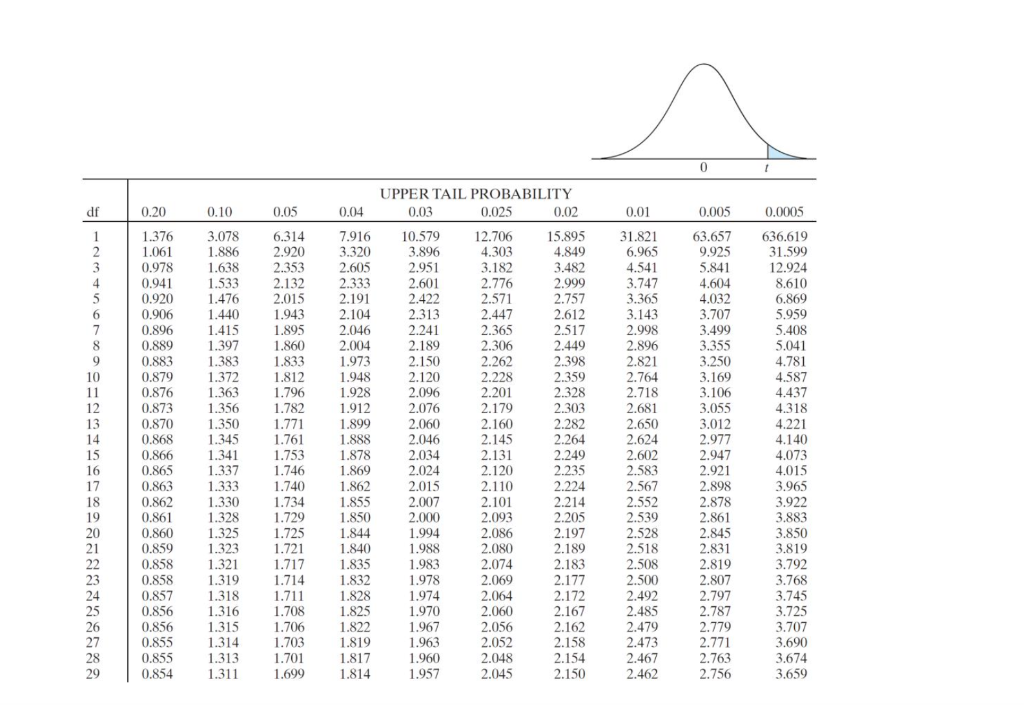Upper Tail Probability Table
The upper quartile sometimes called Q3 is the number dividing the third and fourth quartile. Are used to determine null hypothesis.

Solved My Notes Ask Your Teacher 06 Points Mintrosat97 Chegg Com
What is an Upper Quartile.
. You can also think about the p-value as the total area of the region of rejection. There are also online sites available. The graph of the normal probability distribution is a bell-shaped curve as shown in Figure 73The constants μ and σ 2 are the parameters.
Remember that in a one-tailed test the regi. Next the test statistic is used to conduct the test using either the p-value approach or critical value approach. The only prerequisite is an upper level undergraduate course in probability and mathematical statistics although some familiarity with nonparametric statistics would be useful.
For a 95 confidence interval the area in each tail is equal to 0052 0025. K1 contains the probability that the test statistic assumes a value equal to or greater than that value actually observed based on your sample under Ho. Ex ante the probability of selecting that point is zero.
For an upper-tailed test you need to subtract this probability from 1. T Value Right Tailed is 0031. The particular steps taken in each approach largely depend on the form of the hypothesis test.
You may want to watch the Excel video below as it explains many of these steps in more detail. Choose Calc Calculator. Calculate f i i-0375n025 where i is the position of the data value in the ordered list and n is the number of observations.
Incidentally I would give this problem four stars rather than three --took me days to get it clear. It helps to calculate the value from the Z table very quickly in real-time. Lower tail upper tail or two-tailed.
Cont If you want 196 from 095 you have to make use of the fact that the normal distribution is symmetric and divide the amount youre ignoring in half to get just the upper tail ignored. Copulas are used to describemodel the dependence inter-correlation between random variables. PTS 1785 09629.
How to Draw a Normal Probability Plot By Hand. The right tail has positive values while the left tail has negative ones. The revised second edition includes new sections on extreme value copulas tail dependence and quasi-copulas.
Which numerical summary would you like to calculate for each group. The upper quartile can also be thought of as the median of the upper half of the numbers. Knowledge of measure-theoretic probability is not required.
The value z representing the point on the standard normal density curve such that the probability of observing a value greater than z is equal to p is known as the upper p critical value of the standard normal. The upper quartile is also called the 75th percentile. Arrange your x-values in ascending order.
Remember that Table 2 in Statistics Tables gives areas of the curve below z. I attach my own solution PDF 33K to the problem in case it is of interest. Consequently the p-value measures the compatibility of the data with the.
The following examples show how to do the calculation on the TI-8384 and with R. Namely μ is the population true mean or expected value of the subject phenomenon characterized by the continuous random variable X and σ 2 is the population true variance characterized by the continuous. For this test the rejection region of 005 would be entirely within the upper tail.
The critical zvalue for a probability of 005 in the upper tail is 165. It splits the lowest 75 of data from the highest 25. Stnormppf1-1-0952 1959963984540054 - Basic statistics yes but I just wanted to make it explicit.
The form can easily be identified by looking at the alternative hypothesis H a. The p-value or the observed level of significance is the smallest level of significance at which you can reject the null hypothesis assuming the null hypothesis is true. So you look up the zvalue for a probability of 095.
The complete table of critical values of Z for upper lower and two-tailed tests can be found in the table of Z values to the right in Other Resources. However null hypothesis is the area between right and left tails. If there is a.
You then type in the lower limit upper limit mean standard deviation in. Will calculate the probability for a normal curve including Excel and the TI-8384. Upper Probability is 031.
In Store result in variable enter K2. The command on the TI-8384 is in the DISTR menu and is normalcdf. Ex post the probability must have been greater than zero because it happened.
In probability theory and statistics kurtosis from Greek. The p-value is the probability that the data could deviate from the null hypothesis as much as they did or more. In Expression enter 1-K1.
κυρτός kyrtos or kurtos meaning curved arching is a measure of the tailedness of the probability distribution of a real-valued random variableLike skewness kurtosis describes the shape of a probability distribution and there are different ways of quantifying it for a theoretical distribution and corresponding ways of. Their name introduced by applied mathematician Abe Sklar in 1959 comes from the. In probability theory and statistics a copula is a multivariate cumulative distribution function for which the marginal probability distribution of each variable is uniform on the interval 0 1.

Solved The Skull Width Of A Population Of Rodents Follows A Chegg Com

How To Use The T Table To Solve Statistics Problems Dummies

T Distribution Critical Values Upper Tail Probability Chegg Com

Solved 0 0005 1 895 2 189 2 807 0 Upper Tail Probability Df Chegg Com

0 Response to "Upper Tail Probability Table"
Post a Comment